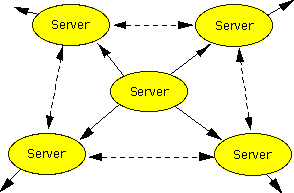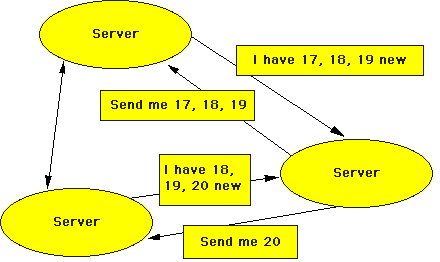| Usenet News is a distributed computer conferencing system. It is interesting
because of this age, early versions of Usenet News were operational already around
1980. To my knowledge no distributed conferending system existed before Usenet News,
even if there were some non-distributed systems operating before Usenet News.
such as Forum-Planet, KOM and Emisary. For many years,
Usenet News was the largest world-wide conference service, even if it today is more and more getting replaced by
more modern social internet systems, such as Facebook. But UsenetNews is not dead, it is still
in operation when this is written (in the year 2016). Conferences in Usenet News are called newsgroups, and messages are called articles. Usenet News is also used for dstribution of binary objects like object code, which is then encoded into a text-like format. Usenet News is one of the oldest distributed conferencing system in the internet, it got supported already in the year 1980. At that time, much of the communication was not done in the internet, but using various other protocols for communication between servers. Topics of newsgroups are about computer usage, but also about cultural and life issues. The basic principle of Usenet News is that local servers handle most of the functionality. Usenet News standardizes two variants of the NNTP protocols: One for communication between adjacent servers, one for communication between a client and a server. Each server can download as much as it wants of what is available on any of the adjacent servers. Loop control is handled both by a trace list and a list of the Message-IDs of received messages stored by each server, so that the server can reject the same message coming back again. This procedure for distribution of news can be compared to pouring water onto a flat horizontal surface; the water flows out in all directions (see the figure below). |
|
"Pouring water" principle of Usenet News distribution |
||||||||||||||||||||||||||||
The figure below shows how new articles are forwarded from server to server in Usenet News. A server tells its adjacent servers which items it offers, the server requests those it has not already got via another route. Sometimes, there is only one way for news to be distributed between groups of servers, for example between Europe and America when Usenet News was young, and communication across the Atlantic was very expensive compared to how it is today. |
||||||||||||||||||||||||||||
|
|
||||||||||||||||||||||||||||
|
The table below lists the most common NNTP commands: |
||||||||||||||||||||||||||||
|
||||||||||||||||||||||||||||
|
Because of this problem, it is better to use the Posted-To header in e-mail to indicate that a message has also been sent to certain newsgroups, and e-mail recipients should ignore any newsgroups heading in an e-mail message. Traditionally, Usenet News has not been using the MIME standard for binary attachments like images. Instead of BASE64, UUENCODING or yEnc is often used in Usenet News to include binary attachments, even if MIME nowadays is also used very much. This did not exist in the beginning of Usenet News, of course, since Usenet News is much older than MIME. Handling binary attachments the MIME way is common in mostly textual discussion groups, which sometimes contain some binary code, like a picture, while yENC is mostly used in special newsgroups intended mostly for distribution of binary code (usually object code of programs). Because of message size restrictions, large attachments are often split into several messages in Usenet News. This also occurs in e-mail, but is more frequent in Usenet News, since some Usenet News servers try to save space by not accepting articles above a certain size limit. Both MIME and Usenet News have methods of indicating how a client can automatically combine parts into a complete message or attachments. |

